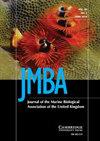揭示福克兰大陆架生态系统的黄蜂腰结构:Doryteuthis gahi 作为关键物种的作用及其营养影响
IF 0.9
4区 生物学
Q3 MARINE & FRESHWATER BIOLOGY
Journal of the Marine Biological Association of the United Kingdom
Pub Date : 2024-02-12
DOI:10.1017/s0025315423000887
引用次数: 0
摘要
福克兰大陆架是西南大西洋的一个高产生态系统。它以上升流海洋动力学为特征,呈黄蜂腰结构,中间营养级物种很少,但有许多顶级捕食者在大陆架上迁徙觅食。其中一种常驻的中间营养级物种--巴塔哥尼亚长鳍鱿 Doryteuthis gahi 数量丰富,在生态系统中发挥着重要作用。我们采用两种方法来估算福克兰大陆架食物网的营养结构,重点关注 D. gahi 的营养生态位及其对其他物种和功能群的影响,以突出 D. gahi 在生态系统中的重要性。首先,稳定同位素测量有助于根据已确定的氮基线计算营养级。其次,建立生态病理学模型来证实稳定同位素得出的营养水平,并了解 D. gahi 与其他功能群的营养相互作用。这两种方法的结果都将 D. gahi 置于生态系统的中心,其营养级约为 3。生态病理学模型预测 D. gahi 的两个季节组群都会受到较大影响,因此具有较高的关键性。我们的研究结果表明,福克兰大陆架不仅受营养链顶层和底层摄食物种的控制。在第三营养级摄食的物种(如 D. gahi 和 Patagonotothen ramsayi)的重要性和观察到的能量流结构证实了生态系统的黄蜂腰结构,其中间控制机制在起作用。本文章由计算机程序翻译,如有差异,请以英文原文为准。
Unveiling the wasp-waist structure of the Falkland shelf ecosystem: the role of Doryteuthis gahi as a keystone species and its trophic influences
The Falkland Shelf is a highly productive ecosystem in the Southwest Atlantic Ocean. It is characterized by upwelling oceanographic dynamics and displays a wasp-waist structure, with few intermediate trophic-level species and many top predators that migrate on the shelf for feeding. One of these resident intermediate trophic-level species, the Patagonian longfin-squid Doryteuthis gahi, is abundant and plays an important role in the ecosystem. We used two methods to estimate the trophic structure of the Falkland Shelf food web, focusing on the trophic niche of D. gahi and its impacts on other species and functional groups to highlight the importance of D. gahi in the ecosystem. First, stable isotope measurements served to calculate trophic levels based on an established nitrogen baseline. Second, an Ecopath model was built to corroborate trophic levels derived from stable isotopes and inform about trophic interactions of D. gahi with other functional groups. The results of both methods placed D. gahi in the centre of the ecosystem with a trophic level of ~ 3. The Ecopath model predicted high impacts and therefore a high keystoneness for both seasonal cohorts of D. gahi. Our results show that the Falkland Shelf is not only controlled by species feeding at the top and the bottom of the trophic chain. The importance of species feeding at the third trophic level (e.g. D. gahi and Patagonotothen ramsayi ) and observed architecture of energy flows confirm the ecosystem's wasp-waist structure with middle-out control mechanisms at play.
求助全文
通过发布文献求助,成功后即可免费获取论文全文。
去求助
来源期刊
CiteScore
2.30
自引率
8.30%
发文量
68
审稿时长
3-8 weeks
期刊介绍:
JMBA is an international journal, publishing original research on all aspects of marine biology. It includes pioneering work taking place today on major issues concerning marine organisms and their environment. Subjects covered include: ecological surveys and population studies of marine communities; physiology and experimental biology; taxonomy, morphology and life history of marine animals and plants; and chemical and physical oceanographic work. Included with 2010 online subscriptions: Marine Biodiversity Records.

 求助内容:
求助内容: 应助结果提醒方式:
应助结果提醒方式:


